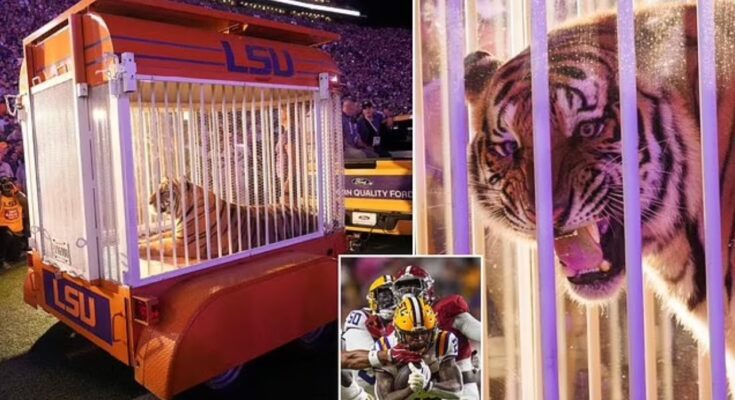LSU Brings Tiger to Field in Controversial Stunt
In a bold move that has sparked intense debate and controversy, Louisiana State University (LSU) recently brought a live tiger onto the football field during a halftime show. The decision to incorporate a real tiger into the performance has raised questions about animal welfare, entertainment ethics, and the boundaries of spectacle in sports.
The Tradition of Live Mascots
LSU is known for its iconic live mascot, the Bengal tiger named Mike the Tiger. For decades, Mike has been a beloved symbol of the university’s spirit and identity, appearing at football games and other events to rally fans and boost morale. However, the decision to bring Mike onto the field during a halftime show marks a significant departure from tradition and has sparked a heated debate among students, alumni, and animal rights activists.
Animal Welfare Concerns
Critics argue that exploiting a live tiger for entertainment purposes is unethical and puts the animal’s welfare at risk. Tigers are wild animals that require immense space, stimulation, and care to thrive in captivity. The loud noises, bright lights, and frenetic energy of a football stadium can be overwhelming and stressful for a tiger, potentially leading to physical and psychological harm.
Furthermore, transporting a live tiger to and from the stadium poses logistical challenges and safety risks. Tigers are powerful predators with the potential to cause serious injury or even death if they were to escape or become agitated in a crowded, chaotic environment. The welfare of both the tiger and the spectators must be carefully considered when making decisions about using live animals in public performances.
Ethical Considerations
The use of live animals in sports entertainment raises broader ethical questions about the boundaries of spectacle and the responsibility of institutions to prioritize the well-being of all participants, human and non-human alike. While live mascots can enhance the fan experience and create memorable moments, it is essential to ensure that the animals involved are treated with respect, dignity, and compassion.
LSU’s decision to bring a live tiger onto the field during a halftime show highlights the tension between tradition, entertainment, and ethics in modern sports culture. As the debate continues to unfold, it is crucial for stakeholders to engage in thoughtful dialogue and consider the implications of their actions on both the animals and the community at large.
Looking Ahead
In response to the controversy surrounding the use of live animals in sports entertainment, LSU has announced that they will be conducting a thorough review of their policies and practices regarding the care and use of their live mascot, Mike the Tiger. This review will include input from animal welfare experts, faculty members, and student representatives to ensure that decisions regarding the handling and display of live animals align with the university’s values and priorities.
As LSU navigates the complexities of integrating live animals into their sporting events, it is essential for them to prioritize the well-being and dignity of their mascot, as well as the principles of compassion, empathy, and ethical responsibility. By approaching this issue with care, transparency, and a commitment to positive change, LSU can set a positive example for other institutions and inspire a more thoughtful, humane approach to the intersection of animals and entertainment in the world of sports.
Conclusion
The controversy surrounding LSU’s decision to bring a live tiger onto the field during a football halftime show raises important questions about animal welfare, ethics, and entertainment in sports. As stakeholders continue to debate the implications of this controversial stunt, it is crucial for institutions like LSU to prioritize the well-being of their animal mascots and consider the broader ethical implications of using live animals in public performances. By approaching this issue with sensitivity, openness, and a commitment to positive change, LSU can set a positive example for the sports community and promote a culture of compassion and respect for all beings involved in the spectacle of athletic competition.



